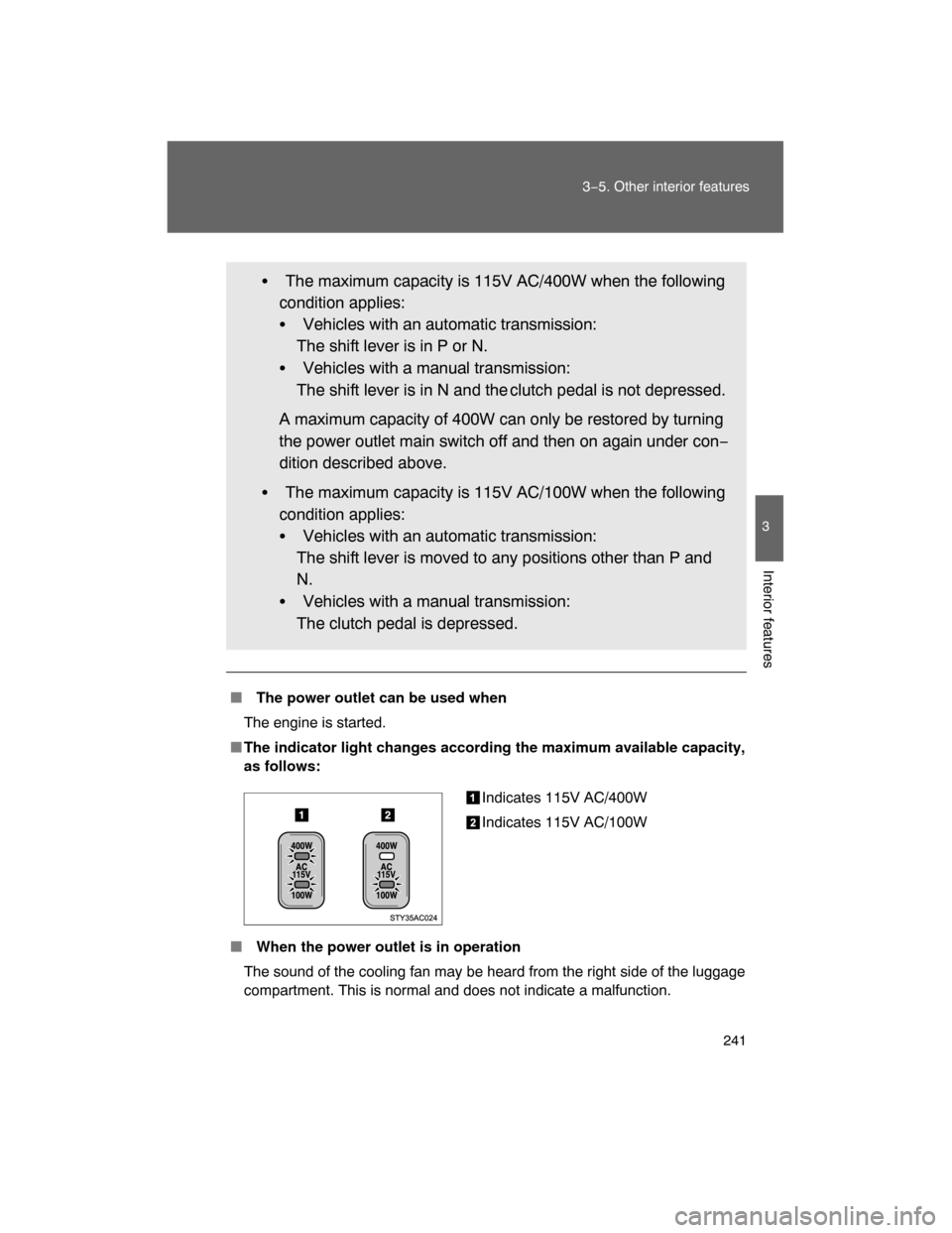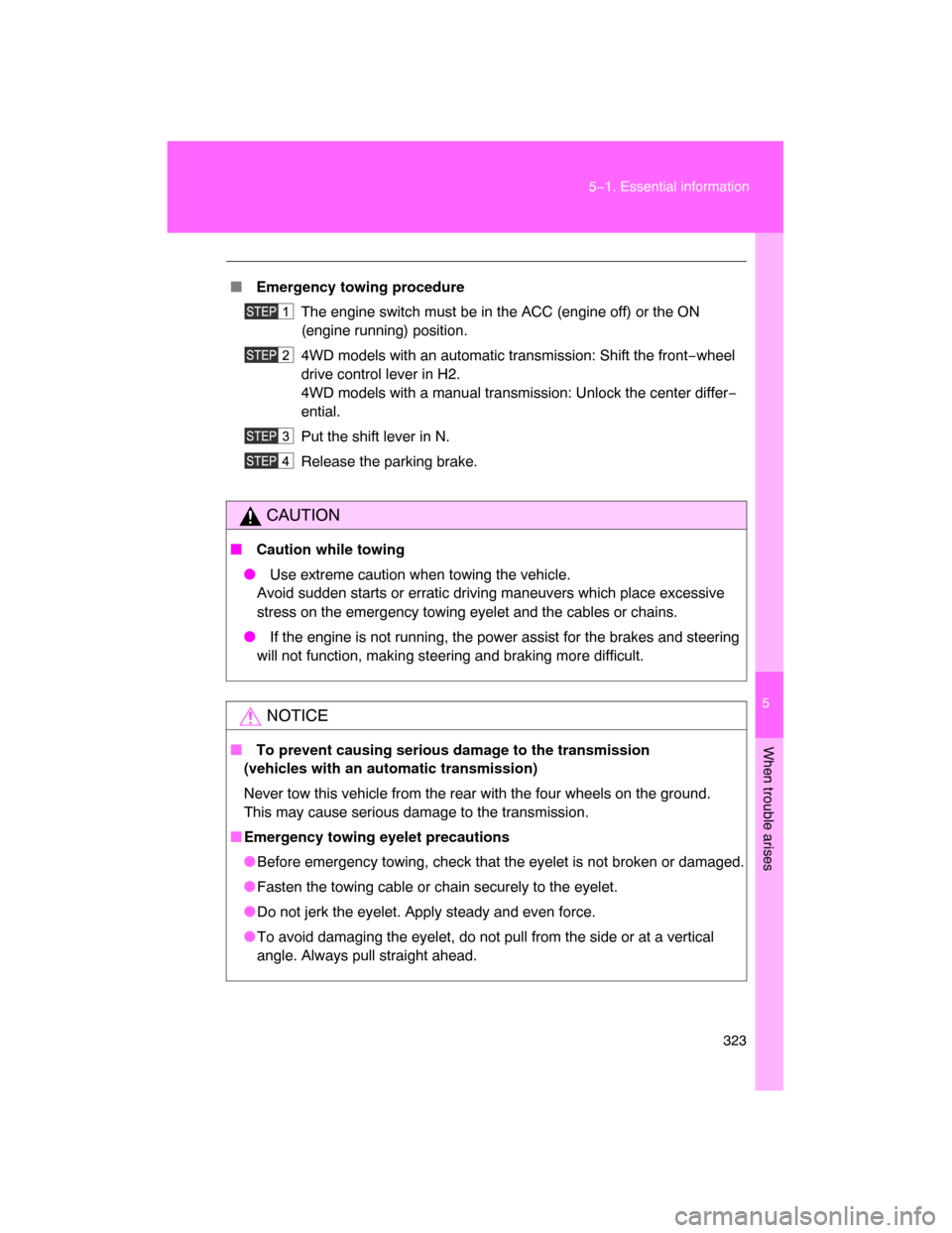Page 227 of 400
230 3−4. Using the storage features
Vehicles with a manual transmission
� Holding large cups
Vehicles with an automatic transmission
Remove the adapter.
Cup holders (front)
Page 238 of 400

241
3−5. Other interior features
3
Interior features
� The power outlet can be used when
The engine is started.
�The indicator light changes according the maximum available capacity,
as follows:
� When the power outlet is in operation
The sound of the cooling fan may be heard from the right side of the luggage
compartment. This is normal and does not indicate a malfunction.
�The maximum capacity is 115V AC/400W when the following
condition applies:
�Vehicles with an automatic transmission:
The shift lever is in P or N.
�Vehicles with a manual transmission:
The shift lever is in N and the clutch pedal is not depressed.
A maximum capacity of 400W can only be restored by turning
the power outlet main switch off and then on again under con−
dition described above.
�The maximum capacity is 115V AC/100W when the following
condition applies:
�Vehicles with an automatic transmission:
The shift lever is moved to any positions other than P and
N.
�Vehicles with a manual transmission:
The clutch pedal is depressed.
Indicates 115V AC/400W
Indicates 115V AC/100W
Page 239 of 400

242 3−5. Other interior features
� If the engine is started with the power outlet main switch on
The maximum capacity of the power supply may decrease to below the stan−
dard, or may be cut off completely, even when the vehicle is stationary.
� The protection circuit may be activat ed to cut the power supply if any
of the following conditions apply:
�The engine is started with the power outlet main switch on.
�Use of electrical appliances exceeding the maximum capacity is
attempted.
A sound may be heard when the protection circuit is activated.
This is normal and does not indicate a malfunction.
� Electrical appliances, which consume power exceeding 100W, have
been used continuously for a long time period.
�The total power usage by all electrical features (headlights, air condition−
ing, etc.) has exceeded the total vehicle maximum for an extended
period of time.
� If the protection circuit is activated
and the power supply is cut, con�
duct the following procedure:
Park the vehicle in a safe place, and then securely apply the park−
ing brake.
Check and ensure the following conditions
Vehicles with an automatic transmission:
The shift lever is in P or N.
Vehicles with a manual transmission:
The shift lever is in N and the clutch pedal is not depressed.
Make sure that the power consumption of the electric appliance is
within the maximum capacity of the power outlet and the appliance
is not broken.
Press the power outlet main switch again.
When the cabin temperature is high, open the windows to cool the tempera−
ture down. Once it reaches the normal temperature, turn the power outlet
main switch on again.
If the power supply is not resumed even after performing the above proce−
dure, have the vehicle inspected by a Toyota dealer.
Page 262 of 400
266 4−2. Maintenance
Vehicle interior
Items Check points
Accelerator pedal�Moves smoothly (without uneven
pedal effort or catching)?
Automatic transmission “Park”
mechanism�Can the vehicle be hold securely
on an incline with the shift lever in
P?
Brake pedal�Moves smoothly?
�Does it have appropriate clear−
ance and correct amount of free
play?
Brakes�Not pull to one side when
applied?
�Loss of brake effectiveness?
�Spongy feeling brake pedal?
�Pedal almost touches floor?
Clutch pedal�Moves smoothly?
�Does it have correct amount of
free play?
Head restraints�Move smoothly and lock
securely?
Indicators/buzzers�Function properly?
Lights�Do all the lights come on?
�Headlights aimed correctly?
( P. 314)
Parking brake�Moves smoothly?
�Can hold the vehicle securely on
an incline?
Seat belts�Does the seat belt system oper−
ate smoothly?
�Are the belts undamaged?
Seats�Do the seat controls operate
properly?
Page 266 of 400
270 4−3. Do−it−yourself maintenance
Items Parts and tools
Light bulbs ( P. 314)�Bulb with same number and watt−
age rating as original
�Phillips−head screwdriver
Power steering fluid level
( P. 282)�Automatic transmission fluid
DEXRON
® II or III
�Rag or paper towel
�Funnel (used only for adding
power steering fluid)
Radiator and condenser
( P. 280)
Tire inflation pressure ( P. 292)�Tire pressure gauge
�Compressed air source
Washer fluid ( P. 286)�Water
�Washer fluid containing antifreeze
(for winter use)
�Funnel (used only for adding
washer fluid)
Page 278 of 400
282 4−3. Do−it−yourself maintenance
Power steering fluid
� Fluid level
The fluid level should be within the appropriate range.
Full (when cold)
Add fluid (when cold)
Full (when hot)
Add fluid (when hot)
Hot: Vehicle has been driven around 50 mph (80 km/h) for 20
minutes, or slightly longer in frigid temperatures. (Fluid
temperature, 140°F − 175°F [60°C − 80°C])
Cold: Engine has not been run for about 5 hours. (Room tem−
perature, 50°F − 85°F[10°C − 30°C])
�
Checking the fluid level
Make sure to check the fluid type and prepare the necessary items.
Clean all dirt off the reservoir.
Remove the cap by turn
ing it counterclockwise.
Wipe the dipstick clean.
Reinstall and remove the reservoir cap again.
Check the fluid level.
Fluid type Automatic transmission fluid DEXRON® II or III
Items Rag or paper towel and funnel (only for adding fluid)
Page 318 of 400

5
When trouble arises
323 5−1. Essential information
� Emergency towing procedure
The engine switch must be in the ACC (engine off) or the ON
(engine running) position.
4WD models with an automatic transmission: Shift the front−wheel
drive control lever in H2.
4WD models with a manual transmission: Unlock the center differ−
ential.
Put the shift lever in N.
Release the parking brake.
CAUTION
� Caution while towing
� Use extreme caution when towing the vehicle.
Avoid sudden starts or erratic driving maneuvers which place excessive
stress on the emergency towing eyelet and the cables or chains.
� If the engine is not running, the power assist for the brakes and steering
will not function, making steering and braking more difficult.
NOTICE
� To prevent causing serious damage to the transmission
(vehicles with an automatic transmission)
Never tow this vehicle from the rear with the four wheels on the ground.
This may cause serious damage to the transmission.
�Emergency towing eyelet precautions
�Before emergency towing, check that the eyelet is not broken or damaged.
�Fasten the towing cable or chain securely to the eyelet.
�Do not jerk the eyelet. Apply steady and even force.
�
To avoid damaging the eyelet, do not pull from the side or at a vertical
angle. Always pull straight ahead.
Page 320 of 400
5
When trouble arises
325 5−1. Essential information
Towing with a wheel lift�type truck from the rear
2WD models
Turn the engine switch to the
ACC position.
4WD models
Vehicles with a manual transmis−
sion: Use a towing dolly under
the front wheels.
Vehicles with an automatic trans−
mission: When not using a tow−
ing dolly, turn the engine switch
to the ACC position, shift the
shift lever to N and shift the front−
wheel drive control lever in H2.
NOTICE
� To prevent causing serious damage to the transmission (4WD models)
Never tow this vehicle wheels on the ground.
�To prevent damaging the vehicle
�Do not tow the vehicle with the key removed or in the LOCK position.
The steering lock mechanism is not strong enough to hold the front wheel
straight.
� When raising the vehicle, ensure adequate ground clearance for towing at
the opposite end of the raised vehicle. Without adequate clearance, the
vehicle could be damaged while being towed.